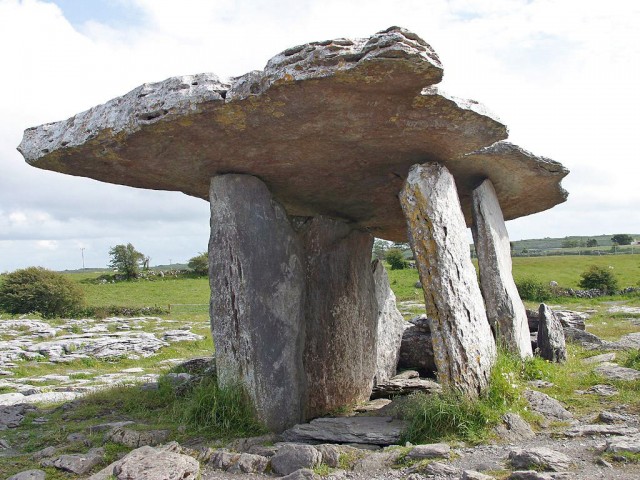megaliths
A GREEK-DERIVED word meaning “large stone,” megaliths refer to huge, uncut, or roughly cut boulders that people have moved to stand upright from the ground. Some megaliths, also called menhirs, have been in place for thousands of years, and the reasons for their positions are not fully known. They are found all over the world.
The most famous megaliths are at Stonehenge, a United Nations World Heritage Site of about 100 acres on the Salisbury Plain in England, UNITED KINGDOM. Stonehenge's construction began around 3150 B.C.E., predating most known cultures of Britain. Simply transporting the stones, which weigh as much as 50 tons (45.3 metric tons), from quarries 17 mi (27 km) and 150 mi (241 km) away, then erecting them on sloping ground in careful circles, involved incredible feats of engineering. The stones are positioned to align with sunrise on the summer solstice, indicating knowledge of astronomy. The organization involved in such an undertaking implies a powerful social administration as well.

Other stone circles have been found in the British Isles and elsewhere. One recently discovered circle dating to 4500 B.C.E., is in Nabta Playa, SUDAN. Research indicates it served as a calendar. The study of archaeoastronomy, started in the 1960s, links many megalithic circles and groups to alignment with astronomical events, such as solstices, eclipses, and the 18.5-year metronomic cycle of the moon's transit.
In addition to circles, megaliths are found in multiple rows. The stones at Carnac, near Morbihan Bay in Brittany, FRANCE, are famous examples of these. Most date from Europe's Iron Age. Megaliths may also be arranged in long avenues, pairs, single rows, triads with a taller center stone, and many other formations. At Callenish on the Isle of Lewis in Scotland, pairs of stones form an avenue that leads to a stone circle surrounding a tomb, with three short rows emanating from it. In 1993, Aubrey Burl catalogued hundreds of megalithic pairs and groupings in Britain, Ireland, and Brittany in his book, From Carnac to Callenish.
Some megaliths are formed as dolmens: the large upright stones form a room, with a stone on top as a roof or capstone. These are also called cromlechs, although the term is not used consistently. Dolmens and chamber tombs have been found above- and belowground in the British Isles, France, SPAIN, ITALY, MALTA, Scandinavia, ETHIOPIA, JORDAN, southern INDIA, CHINA, the KOREAS, JAPAN, and COLOMBIA. In some instances, rough impressions have been carved on the stones. Stones have also been toppled, moved, and reused, and recarved throughout the years.
Standing stones, in any formation or alone, are located all over the world. Granite stones stand in YEMEN, near artifacts dating from 2400 to 1800 B.C.E. In the CAUCASUS MOUNTAINS of RUSSIA, hundreds of dolmans and standing stones, some carved in bas-relief, served as burial chambers. Rows leading to semi–circles of stones have been described in Tibet. Even in the New England states of the UNITED STATES, megaliths have been found standing alone or in groups; the undated complex at Mystery Hill in MASSACHUSETTS is called America's Stonehenge.
Not all megaliths were raised in the distant past. Recently constructed megaliths exist in the Sarawak area of BORNEO, scattered over the foothills near Mount Kinabalu. They were moved and erected in living memory, according to residents, as memorials, sometimes for the dead, and to affirm status or land claims. In MADAGASCAR, megaliths were raised into the 19th century as ancestral tombs.